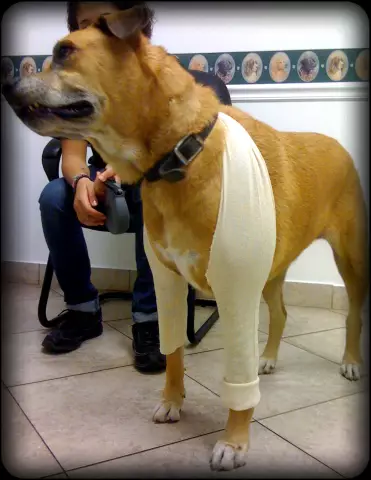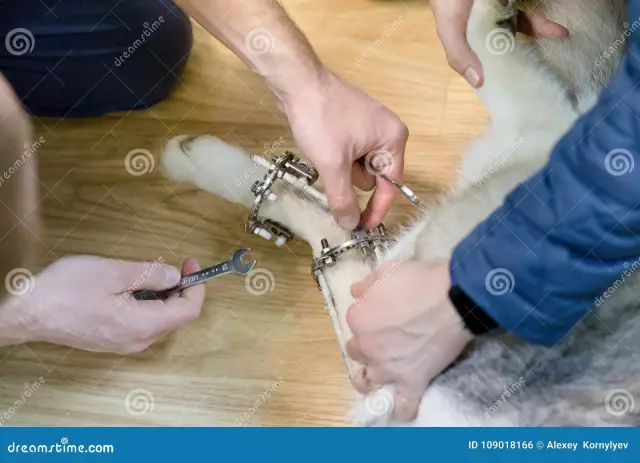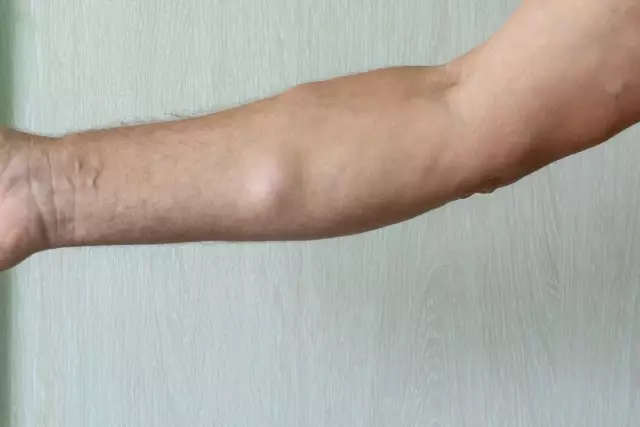- Author Rachel Wainwright [email protected].
- Public 2023-12-15 07:39.
- Last modified 2025-11-02 20:14.
Hygroma
Brief description of the disease

A hygroma is a tumor-like formation (cyst) under the skin in the form of a cavity filled with fluid. Outwardly, it resembles a ball driven under the skin. The most common types of this disease are hand hygroma and joint hygroma.
Hygroma of the hand appears under the skin on the hands, more often in the area of the wrist joint, but can occur on the palms.
Hygroma of the joint is localized in the synovial bags of the joints - wrist, ankle, knee, finger.
The causes of hygroma
Basically, the occurrence of the disease is associated with constant and uniform physical exertion on the joints and tendons, which is why it is also called an occupational disease of people performing repetitive actions with their hands: athletes, musicians, needlewomen, secretaries, for example. The disease can also develop as a complication after trauma, bursitis or tendovaginitis. There are also many known cases when the hygroma arose on its own, for no apparent and significant reason.
Hygroma symptoms
The size of the hygromas are different - from one to six centimeters in diameter.
The disease is often asymptomatic, but painful sensations may appear when loading the affected joints and tendons, when pressing on the cyst and in cases when it has reached a large size.
Diagnostics of the hygroma
During a visual examination of a formation under the skin that looks like a hygroma of a hand or a hygroma of a joint, the doctor must assess its size, shape and correctly identify it, excluding other tumor diseases, abscess and aneurysm of the arteries. In some cases, for a more detailed analysis, a puncture of fluid from the hygroma and an X-ray examination are performed.
Hygroma treatment
At the very beginning of the disease and with a small size of the hygroma, treatment can be carried out using local paraffin and mud applications, physiotherapy procedures.
If local treatment has not brought the desired results or the cyst has reached a large size, a hygroma removal procedure is prescribed. This can be done in two ways:
- surgical intervention;
- laser destruction of the hygroma (carried out without damaging adjacent tissues);
Mixed treatment is also practiced - the education is opened surgically, and further treatment is carried out with the help of medicines. Often this happens when the contents of the hygroma fester, which, after opening it, is sucked off, and the resulting wound is cleaned and drained.

The dissection and removal of the hygroma is usually carried out under local anesthesia, the operation takes about 20-30 minutes. Stitches can be removed after 7-10 days. If the hygroma is large or its location is complex, sometimes a decision is made to perform an operation to remove the hygroma under general anesthesia.
The correct and effective method of treatment can only be chosen after being examined by a qualified doctor.
It is unsafe to treat the hygroma yourself and try to crush it. This leads to the outflow of the contents of the cyst into the tissue, and, as a result, to their suppuration, inflammation. In most cases, after such treatment, the hygroma is restored and even crushed into smaller formations.
Prevention of hygroma
To prevent the onset of the disease, it is necessary to subject the joints, tendons and tissues above them to constant trauma as little as possible, to correctly distribute the load on the limbs. You can practice bandaging joints, tendons with elastic tight bandages.
You should also pay attention in time and treat injuries and diseases that can provoke a hygroma, wear comfortable shoes and correctly selected prostheses.
YouTube video related to the article:
The information is generalized and provided for informational purposes only. At the first sign of illness, see your doctor. Self-medication is hazardous to health!






